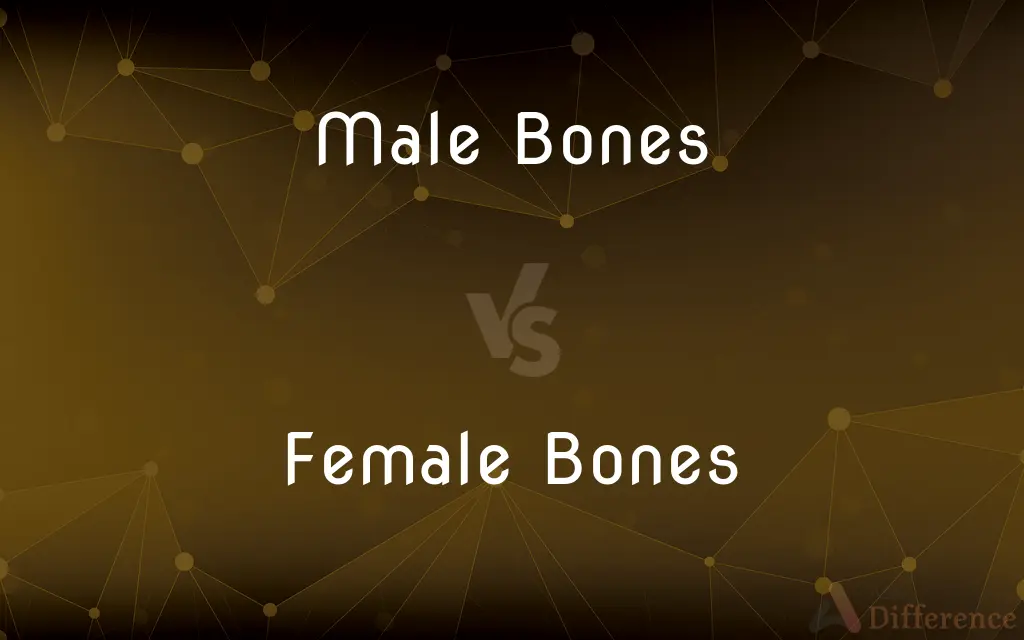Male Bones vs. Female Bones — What's the Difference?
By Tayyaba Rehman — Published on January 7, 2024
Male bones are generally larger and more robust, with more pronounced markings, while female bones are smaller, lighter, with wider pelvic bones for childbirth.

Difference Between Male Bones and Female Bones
Table of Contents
ADVERTISEMENT
Key Differences
Male bones are typically larger and denser than female bones, reflecting differences in muscle mass and physical strength. Female bones, while smaller and lighter, are adapted for childbirth, particularly in the structure of the pelvis.
The male skeleton generally has more pronounced bone markings due to greater muscle attachment. In contrast, female bones have less pronounced markings, correlating with lower muscle mass.
Pelvic differences are significant: male pelvic bones are narrower and more compact, whereas female pelvic bones are wider and more circular, facilitating childbirth.
In terms of bone mass, males typically reach a higher peak bone mass than females, making their bones generally thicker and stronger. Female bones, especially after menopause, are more susceptible to osteoporosis due to hormonal changes.
The skull also shows differences; male skulls are usually more robust with more pronounced brow ridges, while female skulls are smaller and smoother with less pronounced brow ridges.
ADVERTISEMENT
Comparison Chart
Size and Density
Larger and denser.
Smaller and lighter.
Bone Markings
More pronounced due to greater muscle attachment.
Less pronounced.
Pelvic Structure
Narrower and more compact.
Wider and more circular for childbirth.
Peak Bone Mass
Higher peak bone mass.
Lower peak bone mass, more prone to osteoporosis.
Skull Characteristics
Robust with pronounced brow ridges.
Smoother with less pronounced brow ridges.
Compare with Definitions
Male Bones
Male pelvic bones are narrower and more compact.
The male pelvis is structured for support rather than childbirth.
Female Bones
Female bones are generally smaller and lighter.
Female bones in the arm are typically more slender than male bones.
Male Bones
Male skulls are more robust with pronounced features.
Male skulls typically exhibit more pronounced brow ridges.
Female Bones
They have less pronounced bone markings.
The less pronounced muscle attachments are noticeable on female bones.
Male Bones
They have more pronounced markings due to muscle attachments.
The male femur often shows pronounced muscle attachments.
Female Bones
Female pelvic bones are wider for childbirth.
The female pelvis is adapted for childbirth, with a wider opening.
Male Bones
Males generally have a higher peak bone mass.
Male bones, with their higher peak bone mass, are often more robust.
Female Bones
Female skulls are smoother with less pronounced features.
Female skulls usually have less pronounced brow ridges than male skulls.
Male Bones
Male bones are typically larger and denser.
The larger size of male bones is evident in their wider shoulders.
Female Bones
Female bones are more prone to osteoporosis post-menopause.
Female bones often require more care to maintain density after menopause.
Common Curiosities
Do female bones have a higher risk of osteoporosis?
Yes, particularly after menopause due to hormonal changes.
How do female bones differ in the pelvis area?
Female pelvic bones are wider and more circular to facilitate childbirth.
Are male bone markings more pronounced? Why?
Yes, due to greater muscle attachment and physical strength.
Why are male bones generally larger?
Male bones are larger due to differences in muscle mass and physical strength.
What are the skull differences between male and female bones?
Male skulls are more robust with pronounced features, while female skulls are smoother.
How does childbirth impact the structure of female bones?
The female skeletal structure, particularly the pelvis, is adapted to accommodate childbirth.
Why are female bones more susceptible to osteoporosis?
Hormonal changes, especially during menopause, contribute to increased susceptibility.
Is there a significant density difference between male and female bones?
Yes, male bones are typically denser and stronger.
Can the difference in bone structure affect physical performance?
Yes, differences in bone structure can influence muscle attachment and physical capabilities.
Are there differences in the healing process of male and female bones?
Healing rates can vary due to hormonal differences and bone density.
How do hormones affect bone density in males and females?
Hormones like testosterone and estrogen significantly impact bone density and growth.
Are there differences in the rib cage between male and female bones?
Yes, the male rib cage is generally larger and broader.
Is the difference in bone structure noticeable in all bones?
Most differences are noticeable in certain areas like the pelvis, skull, and long bones.
Can exercise impact the strength of male and female bones differently?
Exercise affects both, but the impact may vary due to differences in bone density and structure.
Does age affect male and female bones differently?
Age affects both, but women may experience more significant changes due to menopause.
Share Your Discovery

Previous Comparison
Exact Mass vs. Molecular Weight
Next Comparison
Omelets vs. FrittatasAuthor Spotlight
Written by
Tayyaba RehmanTayyaba Rehman is a distinguished writer, currently serving as a primary contributor to askdifference.com. As a researcher in semantics and etymology, Tayyaba's passion for the complexity of languages and their distinctions has found a perfect home on the platform. Tayyaba delves into the intricacies of language, distinguishing between commonly confused words and phrases, thereby providing clarity for readers worldwide.
















































